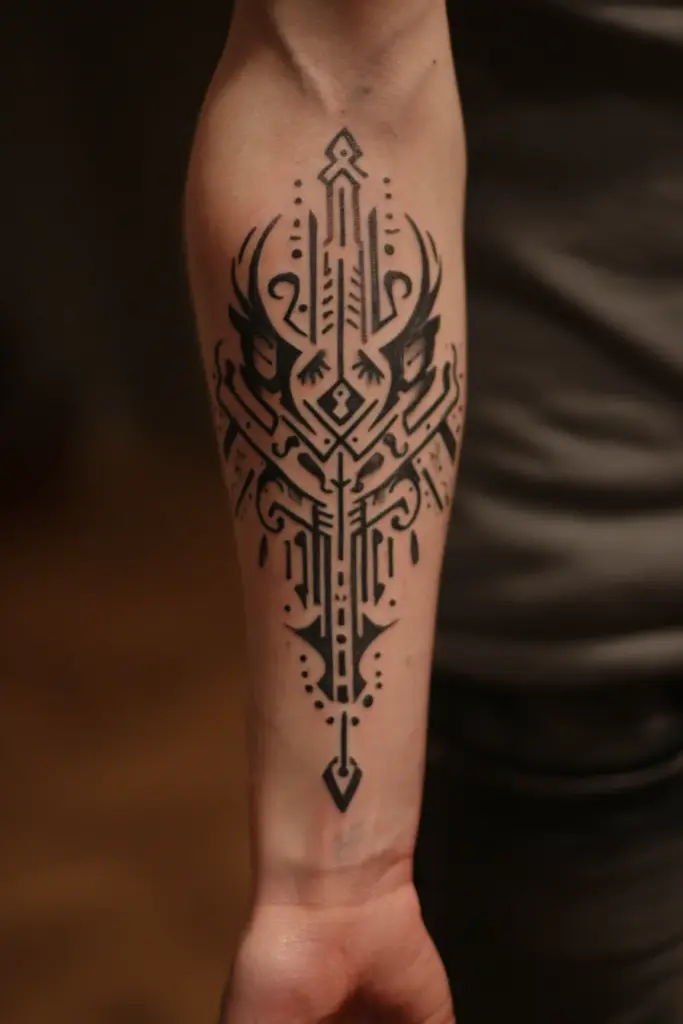Im Hakan, a tattoo consultant and designer with over a decade working across studios in Istanbul and Europe. In this guide I focus on forearm tattoos for men — a versatile placement that suits first-timers and seasoned collectors alike. Forearm pieces can be subtle or bold, running from minimalist line work and small symbols to half-sleeves and photorealistic portraits. Ill walk you through which styles suit different personalities and professions, how size and placement affect pain and visibility, and practical tips on design flow, contrast, and wearing sleeves at work. This post includes 10 curated images to inspire proportion, negative space and integration with existing ink. Whether you want a geometric band, tribal motif, or blackwork statement, Ill help you choose a concept that fits your anatomy and lifestyle and explain how to prepare for — and heal — your forearm tattoo.
Realistic Lion Crown Forearm Tattoo — Black & Gray Masculine Design
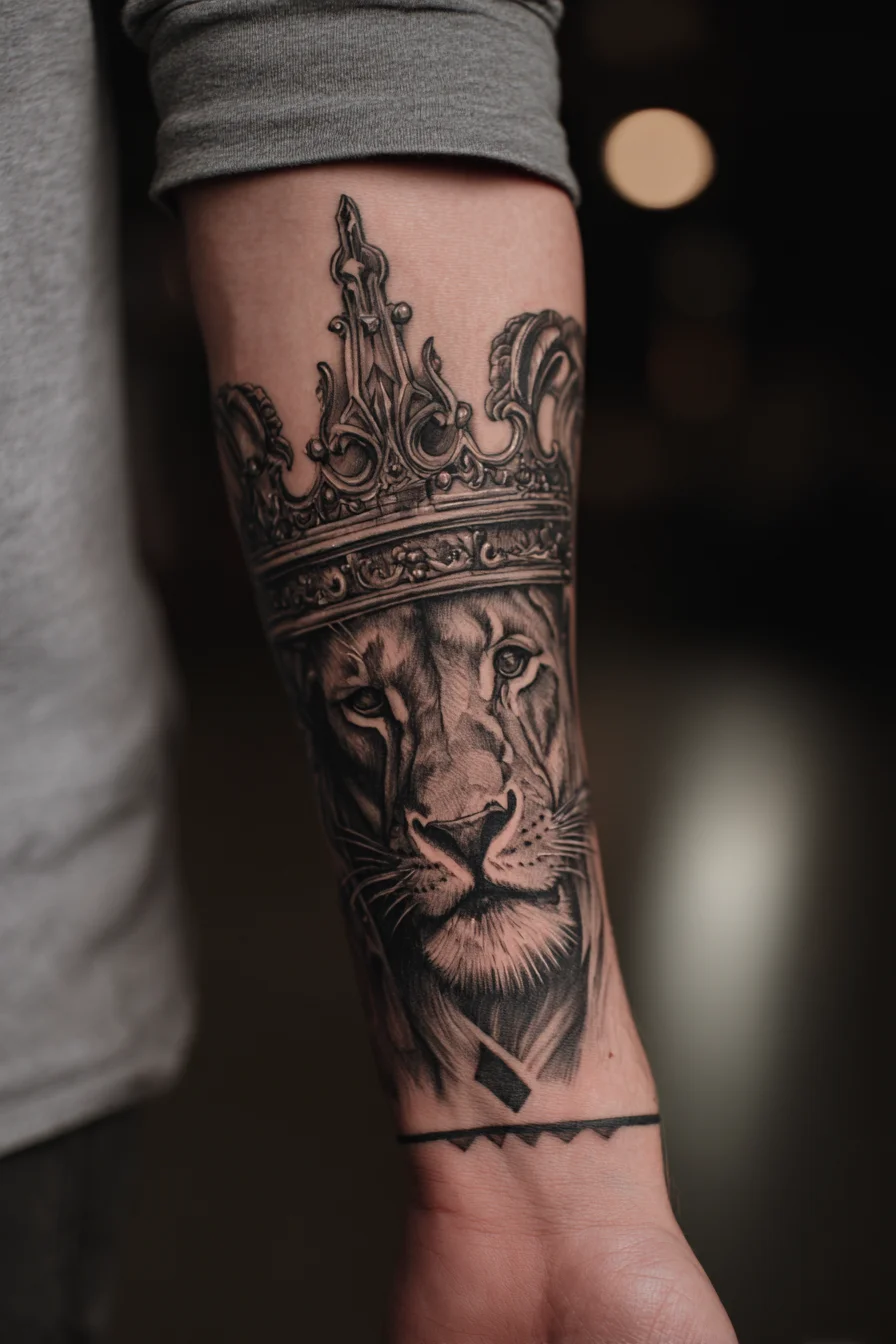
A photo-realistic lion wearing an ornate crown is a classic masculine piece symbolizing leadership, strength, and personal sovereignty. Ideal for men who want a bold yet elegant statement, this black-and-gray design reads well on the forearm and can be scaled into a half- or full-sleeve. Placement suggestions: outer forearm for lower pain and daily visibility; inner forearm for intimacy and detailed viewing; extend toward the bicep, chest, or calf to create continuity with larger compositions. Pain expectations: outer forearm is low–moderate, while the inner forearm and areas near the wrist or bone are more sensitive; expect 2–4 hour sessions for medium pieces and multiple sessions for highly detailed, larger work. Size considerations: to preserve facial detail and crown filigree, plan for at least 15–20 cm (6–8 in) of vertical space; larger sizes allow finer shading and longer-lasting clarity. Styling variations include photorealism (black & gray), neo-traditional linework, geometric crown elements, dotwork/negative-space mane, or subtle gold/yellow highlights on the crown. Discuss skin tone, contrast, and touch-up scheduling with your artist and follow proper aftercare for optimal healing.
Black‑and‑Grey Ram Skull Forearm Tattoo — Skull, Geometric & Ornamental
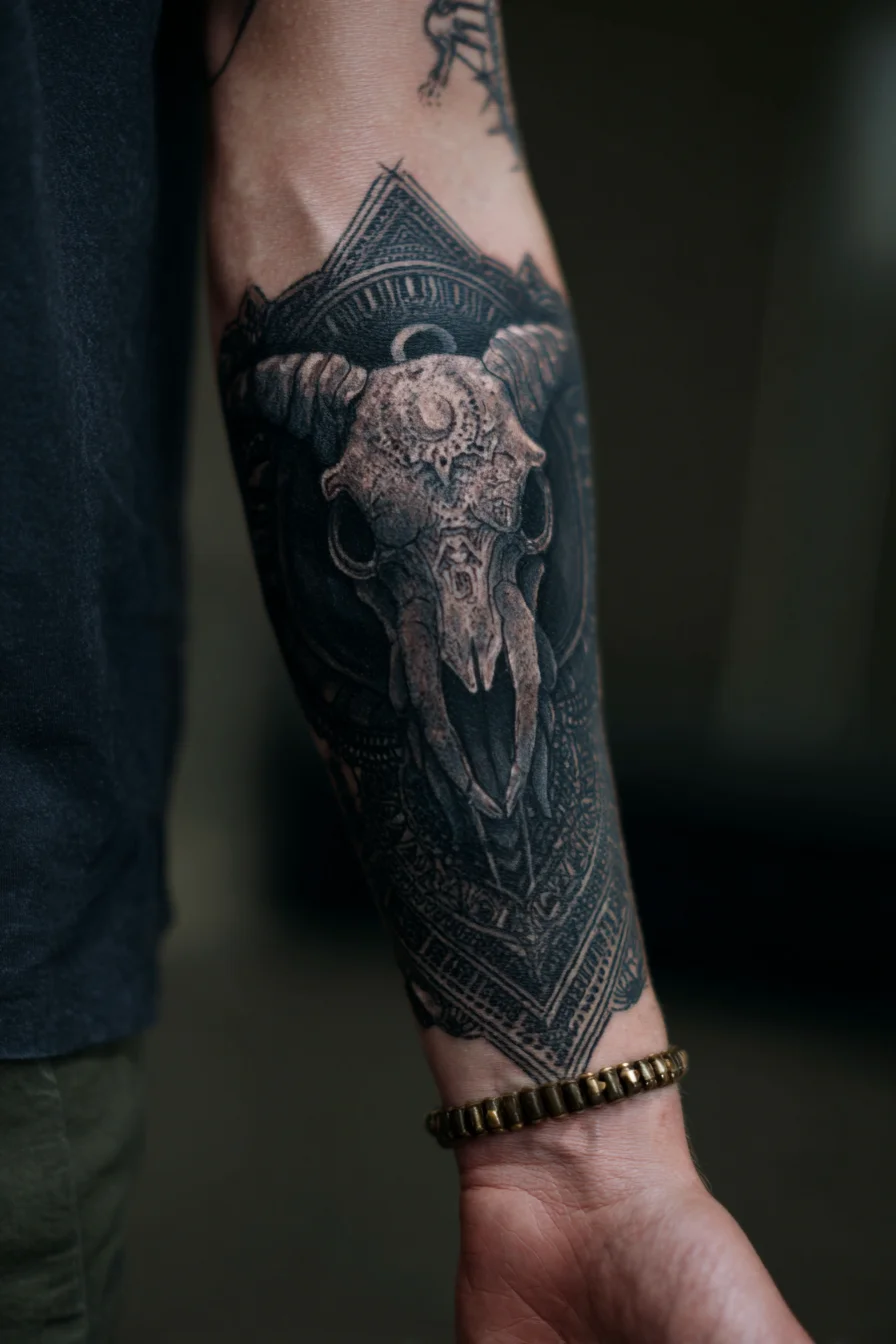
This black-and-grey ram/bovine skull paired with geometric and ornamental mandala work reads as a masculine, symbolic piece: skull imagery suggests mortality, resilience, and primal strength while the patterned backdrop adds balance and spiritual symmetry. Ideal placement is the inner or outer forearm where the vertical skull composition follows natural forearm lines; it also scales well as a half-sleeve extension onto the bicep or shoulder. Expect pain to be low-to-moderate on the outer forearm and slightly higher on the inner forearm and near the wrist or elbow — shading and dense black areas can increase discomfort during longer sessions. Size considerations: keep it medium to large (6–10 inches/15–25 cm) to preserve fine ornamental detail and realistic texture; smaller reductions will lose subtle shading. Styling variations that suit men include full realism or neo-traditional black-and-grey, dotwork mandala backgrounds for texture, bold linework for contrast, or warm color accents (rust, sepia) to suggest aged bone. Discuss spacing for future pieces and maintenance/touch-ups with your artist to ensure longevity in high-movement areas.
Realistic Black & Grey Forearm Clock and Classical Face Sleeve Tattoo
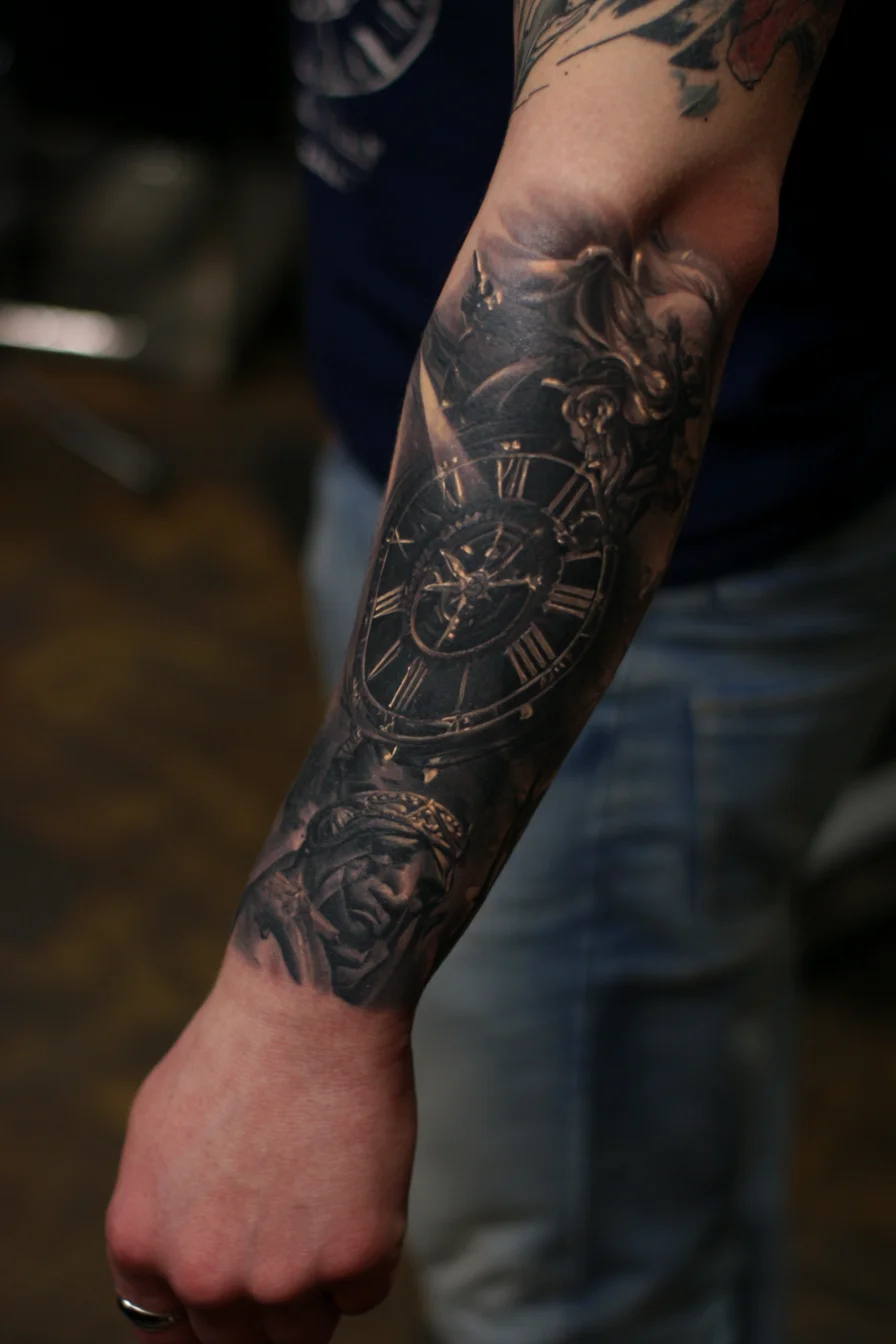
This black-and-grey forearm design pairs a highly detailed clock face with a carved classical visage, creating a masculine narrative of time, mortality, legacy and stoic resolve. The clock and Roman numerals read clearly in realism, while the statue-like portrait adds emotional weight and depth. Placement: ideal for the outer or inner forearm where the elongated canvas lets the clock sit naturally between wrist and elbow; the design also scales up to a half or full sleeve by extending background shading around the bicep and elbow. Pain expectations: outer forearm work is generally low-to-moderate pain for most men; expect increased sensitivity over the inner forearm, wrist bones and near the elbow — plan shorter sessions in those areas. Size considerations: to preserve fine detail and legible numerals, aim for a minimum length of 6–8 inches and moderate width; full realistic shading benefits from larger scale. Styling variations: keep it pure black-and-grey realism, add selective gold or bronze highlights on the clock, introduce geometric or dotwork backgrounds, or incorporate script/date elements for personalization. Expect multiple sessions and standard healing and touch-up needs.
Intricate Horned Beast Forearm Tattoo — Norse-Inspired Blackwork
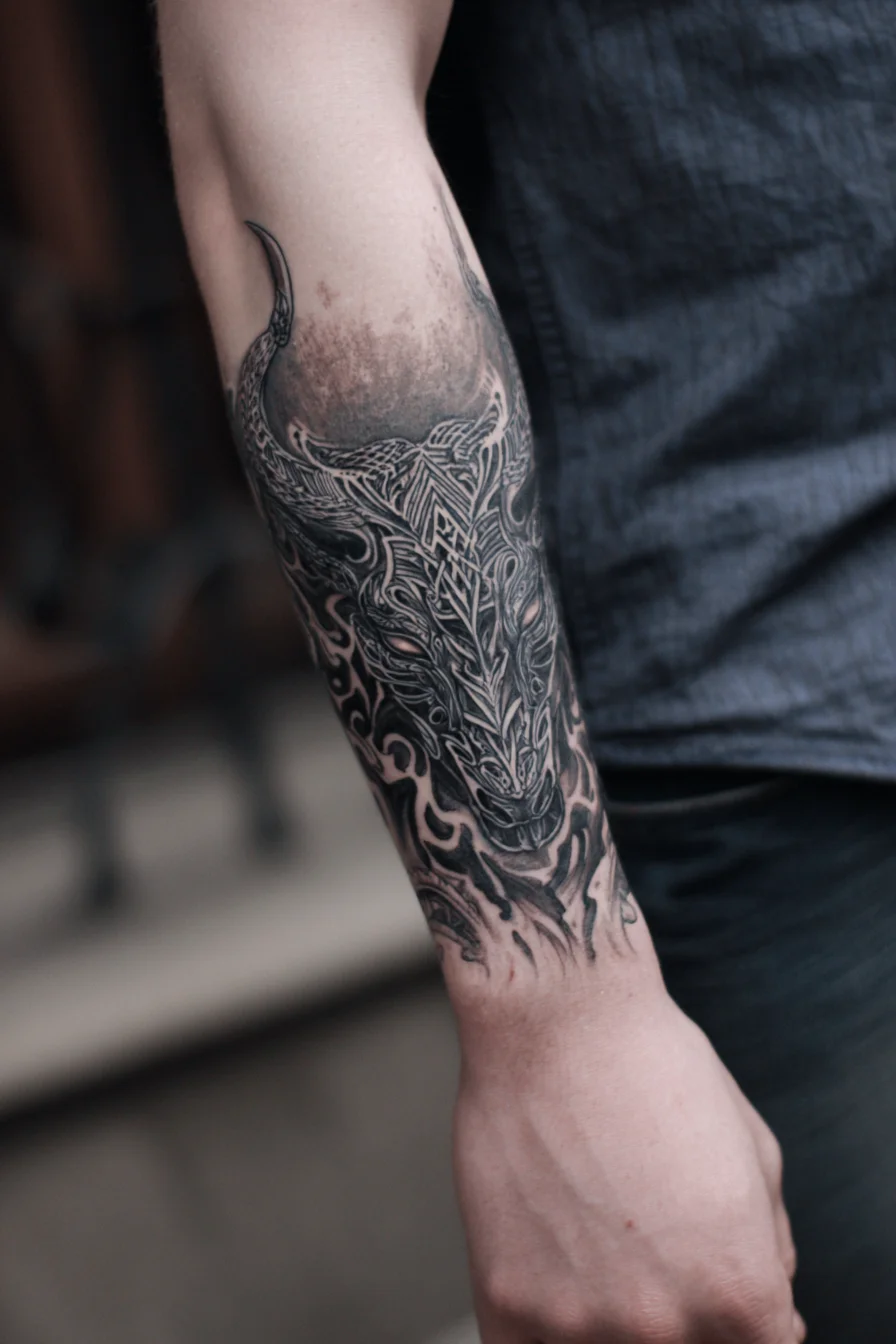
An intricately patterned horned beast rendered in bold blackwork and fine-line detail, this design evokes Norse and tribal themes of protection, primal strength, and guarded masculinity. It’s composed to flow down the forearm, using negative space and textured shading to emphasize the horns and facial symmetry. Placement suggestions: ideal on the outer forearm for maximum visibility, or the inner forearm for a more personal piece; it can extend toward the elbow or wrist to become a half-sleeve. Pain expectations: forearm tattoos are generally low-to-moderate in discomfort — expect sharper sensitivity near the wrist, inner arm and elbow creases, and over bony areas. Size considerations: keep the design medium-to-large (approximately 6–10 inches / 15–25 cm) so the detailed linework remains legible; scaling it down too far will blur fine elements. Styling variations: convert to heavier blackwork for a graphic statement, add dotwork or stippling for texture, introduce muted reds or rust tones for depth, or incorporate runes and geometric borders to personalize the Norse feel. Discuss stencil scale and contrast with your artist to preserve detail and longevity.
Black & Grey Compass and Storm Forearm Tattoo — Nautical Navigation Design
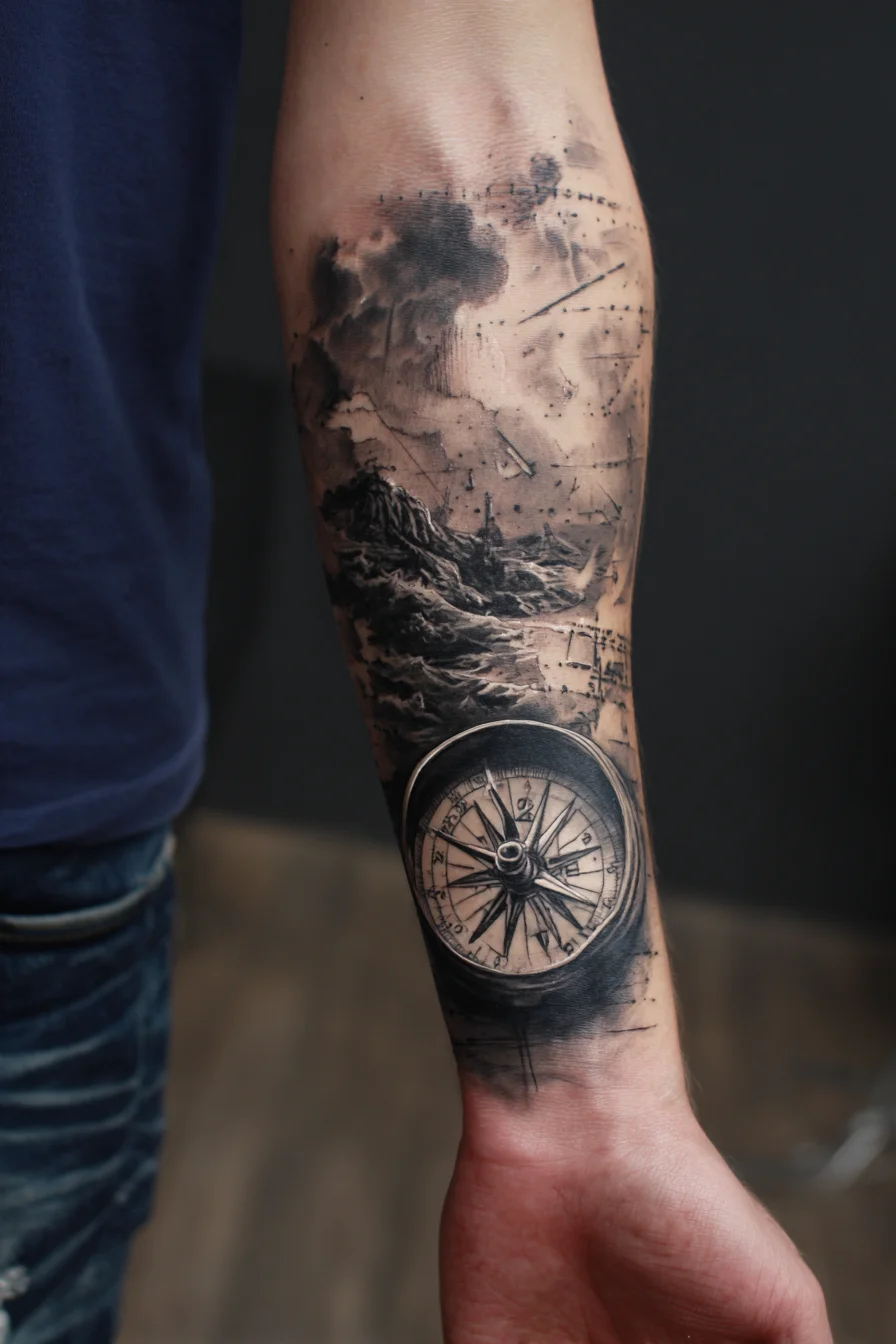
This black-and-grey forearm design pairs a realistic compass with a stormy sea and map-like textures to symbolize direction, resilience, and life’s turbulent journeys. For men wanting a statement piece, the compass anchors the composition as a symbol of guidance while the waves and clouds add narrative depth and movement. Placement suggestions: inner or outer forearm (wrist to elbow) for visibility and easy display; the same layout adapts well to the upper arm, chest panel or full sleeve if you want to extend the scene. Pain expectations: forearm skin is moderate—shading and heavy blackwork feel tolerable for most, but expect increased sensitivity around the wrist, inner wrist crease, and near the elbow. Size considerations: preserve the compass detail by keeping the main element at least 4–6 inches (10–15 cm) across; full forearm scaling improves the landscape transitions and aging. Styling variations: keep it pure black & grey realism, add subtle color accents (teal or sepia), incorporate dotwork or negative space, or pair with script, coordinates, a ship, or an anchor for a personalized nautical theme. Consult your artist for line weight, session planning, and curvature mapping to your anatomy.
Geometric Stag Forearm Tattoo — Blackwork Deer with Linework & Dotwork
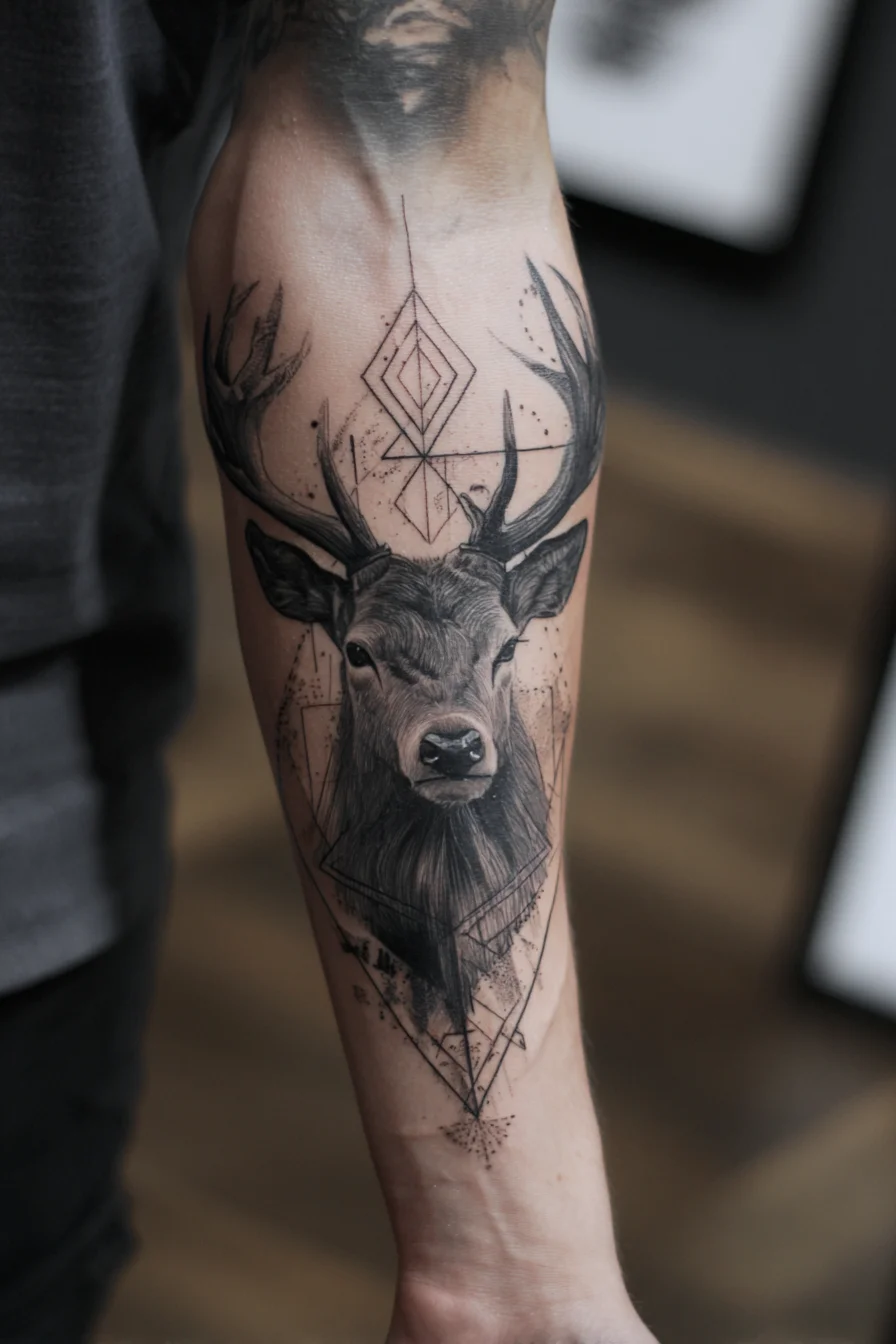
This geometric stag design combines realistic blackwork portraiture with precise linework and dotwork geometry to create a masculine, modern piece. Meaning: the stag often symbolizes strength, leadership, endurance and a deep connection to nature—an ideal choice for men who want a bold but meaningful image. Placement: it reads very well on the outer or inner forearm, where the vertical composition follows the arm’s natural lines; it also scales to the upper arm, chest, or calf as a single-piece or part of a sleeve. Pain expectations: forearm placements are generally moderate in discomfort—outer forearm is less sensitive, inner forearm closer to sensitive nerves; expect higher pain near the wrist, elbow crease, and over bone. Size considerations: keep the detailed head and antler work medium to large (roughly 12–20 cm / 5–8 in) to preserve shading and line clarity; very small versions will lose fine texture. Styling variations: opt for pure blackwork for contrast, add subtle earth-tone washes, or emphasize geometric elements with negative space or fine dotwork. Discuss flow and scale with your tattooist to tailor the piece to your anatomy and lifestyle.
Black & Grey Realistic Old Man Portrait Forearm Tattoo
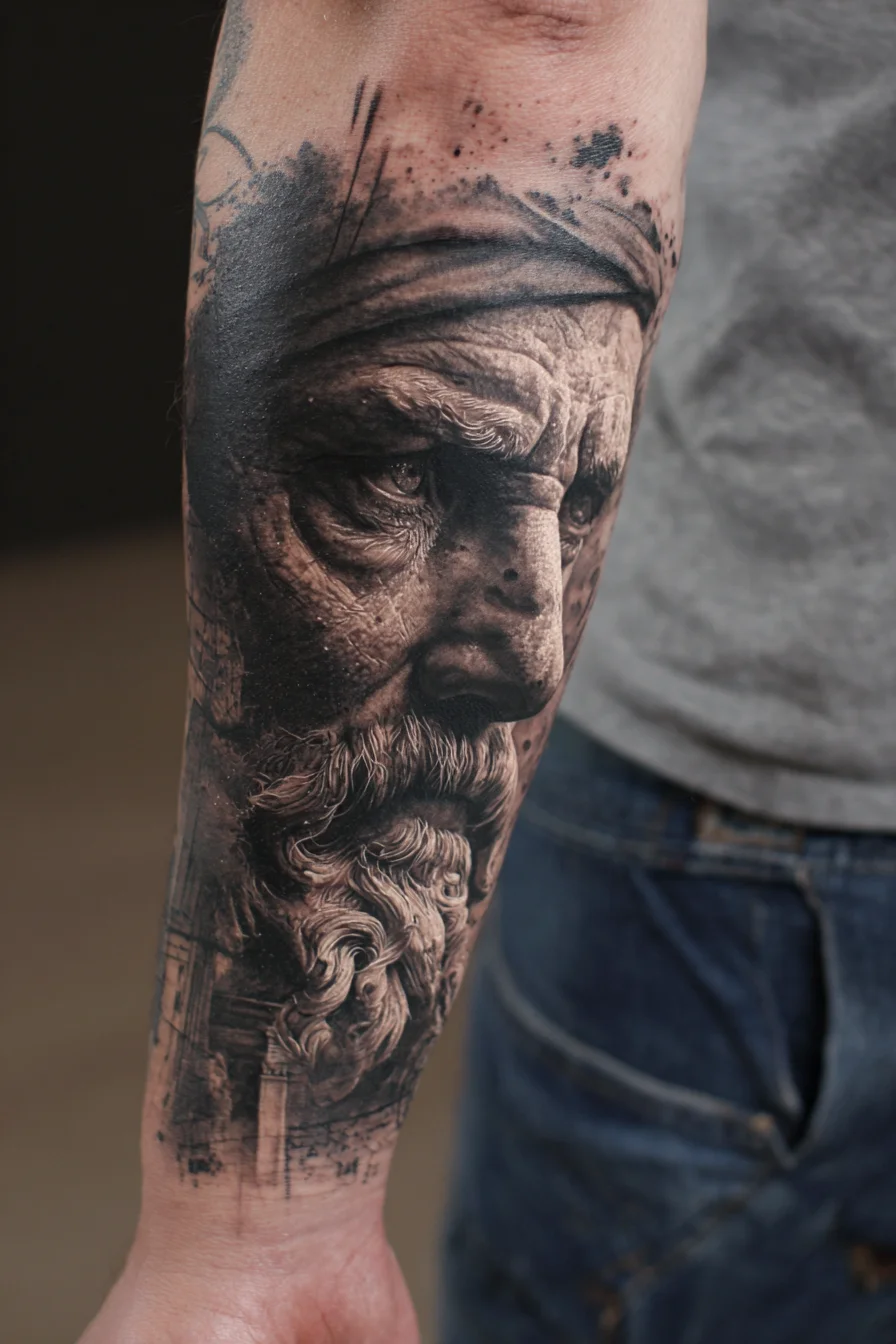
This hyper-realistic black-and-grey portrait evokes wisdom, resilience and a lived history — ideal for men wanting a symbolic piece that reads like a personal totem. The deep wrinkles, textured beard and intense gaze speak to experience, legacy and stoicism. Placement recommendations: the outer or inner forearm (as shown) is perfect for visibility and elongation; the design also adapts well to a half- or full-sleeve, upper arm, chest or calf if you want a larger canvas or easier concealment. Pain expectations: forearm work is generally moderate — flatter outer forearm areas are less sensitive, while the inner wrist, elbow crease and bony regions feel sharper. Expect multiple long sessions (4+ hours each) and occasional touch-ups for fine contrast. Size considerations: for this level of facial detail, plan on at least 6–8 inches (15–20 cm) vertical height; an 8–12 inch (20–30 cm) piece will retain micro-details and age better. Styling variations: stick with high-contrast black & grey realism, add selective color (eye or background), introduce geometric frames, dotwork textures or architectural elements for a modern twist. Consult a portrait specialist for stencil placement and reference matching.
Bold Geometric Tribal Sword Forearm Tattoo — Blackwork Ornament
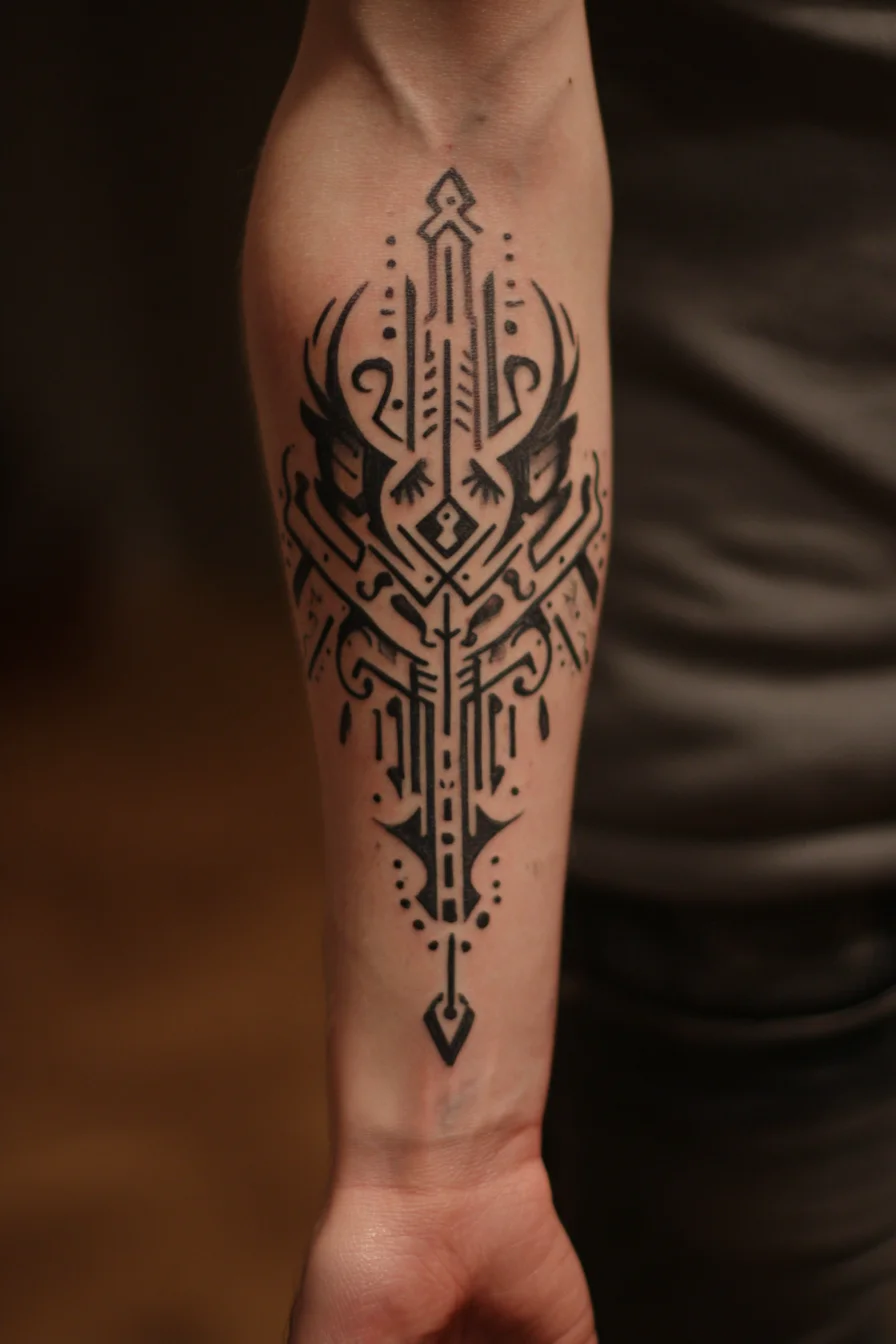
This symmetrical blackwork design reads as a stylized sword or spear fused with tribal geometry — a masculine motif that communicates strength, direction and protective intent. The central vertical axis and mirrored ornamentation create a balanced, commanding look suited for men wanting bold, minimal-color body art. Placement suggestions: the inner forearm shown is ideal for visibility and controlled pain; consider the outer forearm, upper arm, chest center, or calf for a larger canvas or integration into a sleeve. Pain expectations: overall low-to-moderate on fleshy forearm areas, with increased sensitivity near the wrist, elbow crease and bony spots; thick black lines are generally quicker and more tolerable than prolonged fine-line shading. Size considerations: keep the main vertical element proportional to forearm length — typically 4–8 inches (10–20 cm) depending on body size — and scale width to avoid wrapping awkwardly around muscles. Styling variations: solid black, heavy linework or dotwork shading, negative-space highlights, subtle graywash for depth, or selective color accents. Consult your artist for stencil placement, symmetry tweaks and integration into future pieces.
Sun‑Moon Mandala Forearm Tattoo — Black & Grey Geometric Sunburst
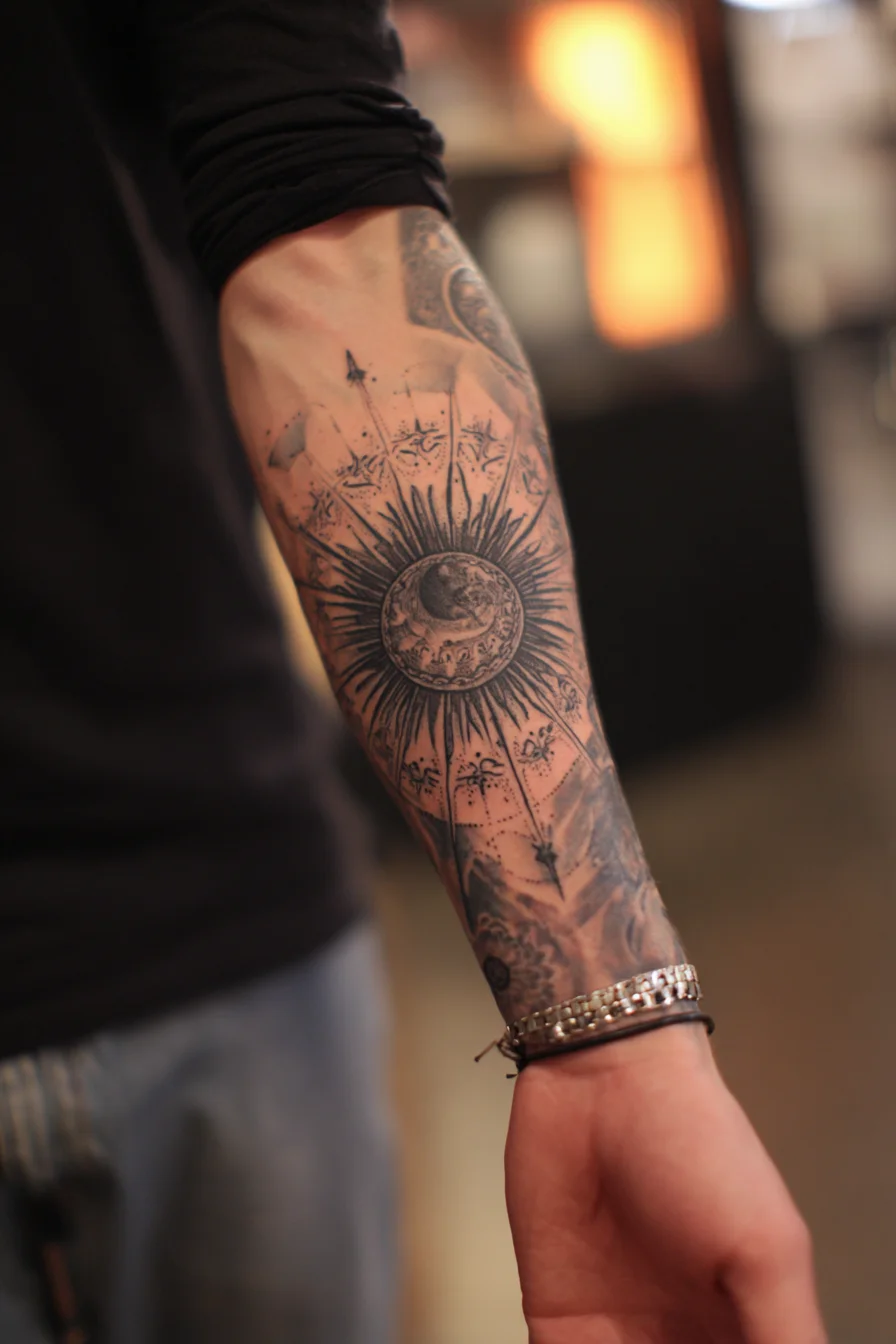
This design combines a detailed sunburst with a lunar centerpiece and ornamental dotwork, symbolizing balance, cycles, and personal navigation. For men looking for a meaningful forearm piece, it reads well as a standalone half‑sleeve or integrated into a larger sleeve where the rays and arrows can link to other elements. Placement suggestions: inner forearm (shown) for visibility and intimacy, outer forearm for a bolder display, or scaled to the upper arm/chest or calf to convert into a fuller sleeve. Pain and healing: expect moderate discomfort on the inner forearm — generally tolerable for most — with increased sensitivity toward the wrist, elbow crease, and over the ulna. Sessions are best broken into 1–3 hour blocks depending on tolerance. Size and detail: the intricate moon engraving and fine rays require medium to large dimensions to remain crisp over time (aim for at least 3–5 in / 8–13 cm wide). Styling variations include pure black & grey dotwork, heavier neo‑traditional outlines, subtle color fills or watercolor backgrounds, and negative‑space mandala extensions. Always consult your artist about line thickness and skin type for long‑term clarity.
Masculine Minimalist Compass Tattoo — Forearm, Shoulder & Chest Placement
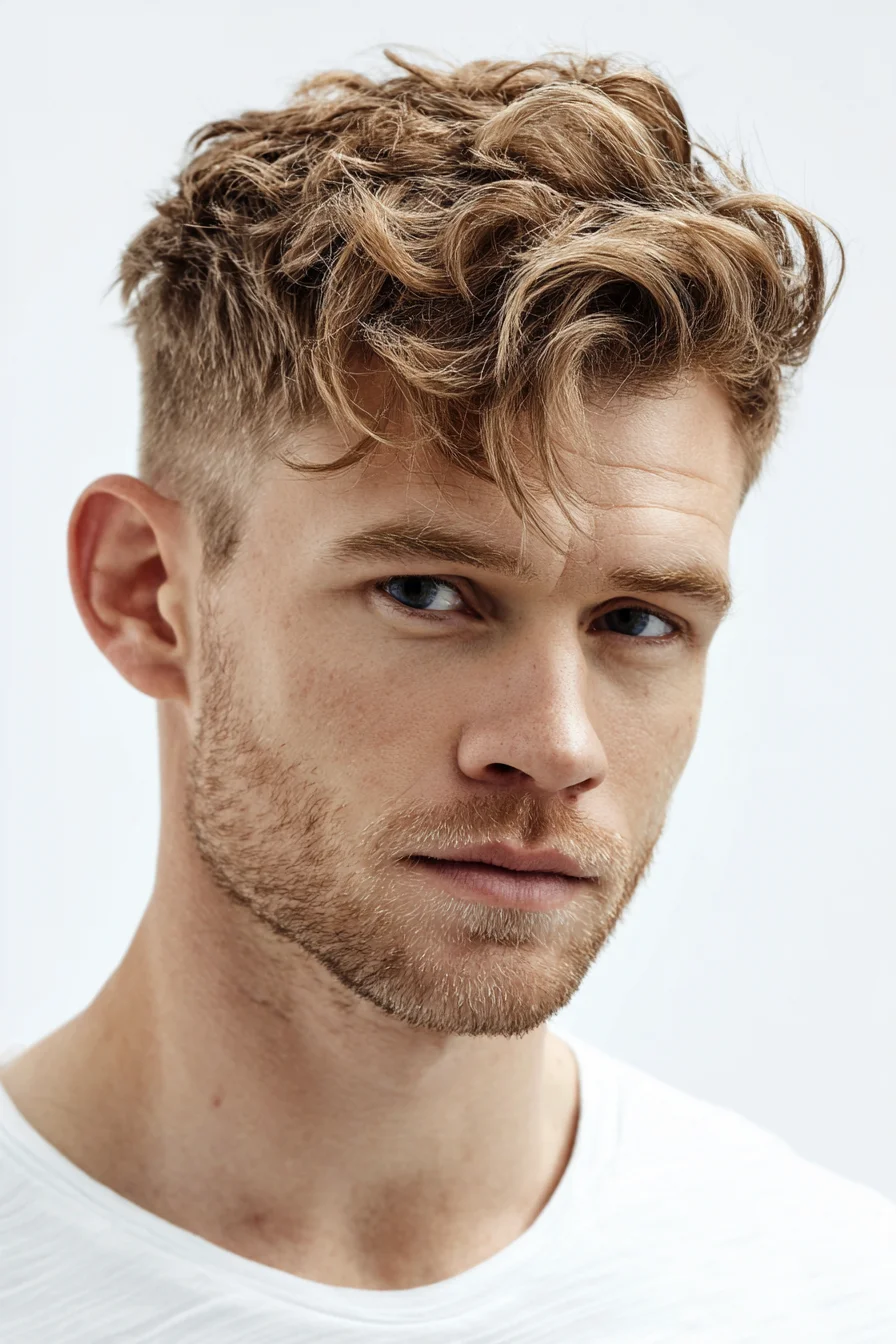
This clean, masculine compass tattoo reads as a symbol of direction, personal values and resilience — a strong choice for men who want an understated yet meaningful piece. Design meaning centers on life’s journey, leadership and inner navigation; it pairs well with initials, coordinates or a subtle map overlay to personalize the concept. Placement suggestions: low-pain areas like the outer forearm, upper shoulder or chest provide visibility and ease of healing; consider ribs, sternum or inner bicep for more private, higher-impact placements. Pain level expectations: outer forearm and shoulder are low-to-moderate; chest and inner bicep are moderate; ribs, sternum and spine are high. Size considerations: small 2–4 inch pieces work well for wrists or inner forearms; 4–8 inch versions suit upper arm and chest; expand to half-sleeve if you want background elements. Styling variations: fine-line blackwork for a modern discreet look, bold black neo-traditional for durability, dotwork or stippling for texture, and selective color accents (navy or rust) to highlight cardinal points. Discuss ink density and placement with your artist for longevity and touch-up expectations.
Choosing a forearm tattoo is a commitment that balances aesthetics, visibility and long-term wear. From my 10+ years consulting, my practical advice: bring clear reference images (one of the 10 gallery shots helps), discuss scale and curvature with your artist, and be honest about your job dress code. For thicker blackwork or photorealism, plan for sufficient contrast and shading to age well; for fine-line or minimalist pieces, accept that periodic touch-ups may be needed. Follow strict aftercare: gentle cleanser, thin layer of tattoo ointment or fragrance-free moisturizer, no submersion for two weeks, and daily SPF after healing. Book a consultation—view the 10 images in this post to start a conversation—and choose a licensed artist whose portfolio matches your chosen style. With the right prep and artist, a forearm tattoo becomes a confident, wearable statement that grows better with time.
